Artist-in-Residence AGNS Yarmouth Anselm Kiefer - Art Gallery of ...
Artist-in-Residence AGNS Yarmouth Anselm Kiefer - Art Gallery of ...
Artist-in-Residence AGNS Yarmouth Anselm Kiefer - Art Gallery of ...
You also want an ePaper? Increase the reach of your titles
YUMPU automatically turns print PDFs into web optimized ePapers that Google loves.
20<br />
<strong><strong>Art</strong>ist</strong> <strong>in</strong> <strong>Residence</strong><br />
A horse is a horse <strong>of</strong> course,<br />
unless that horse is David Harper’s horse…<br />
You don’t need to know the story <strong>of</strong> The Last<br />
to W<strong>in</strong> to be struck by its beauty. The life size<br />
horse is immediate, breathtak<strong>in</strong>g, and<br />
touchable. one can almost catch a glimpse<br />
<strong>of</strong> muscles twitch<strong>in</strong>g under sk<strong>in</strong> or feel<br />
its s<strong>of</strong>t, hot breath. However, with closer<br />
scrut<strong>in</strong>y, its stitched seams and glass eyes<br />
betray that beauty, reveal<strong>in</strong>g a carefully<br />
constructed fiction.<br />
This is where the story beg<strong>in</strong>s for this horse.<br />
with his work, David R. Harper domesticates<br />
and dissects the natural world. He br<strong>in</strong>gs<br />
the outside world <strong>in</strong> as though through an<br />
open bedroom w<strong>in</strong>dow. Bird, squirrel, and<br />
chipmunk creep <strong>in</strong> to jo<strong>in</strong> owl, beaver and<br />
black bear. Through sculpture and embroidery<br />
Harper also br<strong>in</strong>gs the <strong>in</strong>side out: he<br />
shaves and peels back protective cover<strong>in</strong>gs to<br />
reveal s<strong>of</strong>tly stitched bones and organs. with<br />
a sense <strong>of</strong> reverence and care, he f<strong>in</strong>ds ways to<br />
celebrate the spirit <strong>of</strong> the animals he recreates.<br />
Narrative creeps <strong>in</strong>to Harper’s practice as he<br />
weaves stories and histories for his animals.<br />
The story is clear for the birds, mice, raccoons,<br />
and many other animals that <strong>in</strong>habit<br />
the half-sized camp<strong>in</strong>g trailer he made for his<br />
<strong>in</strong>stallation When the ra<strong>in</strong> Comes. In impish<br />
pairs, these creatures await the flood, be it<br />
Biblical or the unrelent<strong>in</strong>g encroachment<br />
<strong>of</strong> suburban sprawl on their once wild land.<br />
His awareness <strong>of</strong> the delicate balance<br />
between the natural world and human<br />
<strong>in</strong>tervention adds to this narrative.<br />
JOURNAL Spr<strong>in</strong>g & Summer 2009<br />
In Harper’s work, his passion for the wild<br />
unites synergistically with a keen <strong>in</strong>terest <strong>in</strong><br />
technique. His sculptures, even those small<br />
<strong>in</strong> scale, have weight and presence. His vision<br />
for The Last to W<strong>in</strong> was huge, both l<strong>of</strong>ty and<br />
ambitious: a full-scale horse, crafted <strong>in</strong> the<br />
modest <strong><strong>Art</strong>ist</strong>-<strong>in</strong>-<strong>Residence</strong> studio at the <strong>Art</strong><br />
<strong>Gallery</strong> <strong>of</strong> Nova Scotia, appropriately dur<strong>in</strong>g<br />
the run <strong>of</strong> a Joe fafard retrospective. Harper’s<br />
desire to create a horse <strong>of</strong> this stature predates<br />
the <strong>AGNS</strong> residency, although creat<strong>in</strong>g<br />
it with<strong>in</strong> that context gave Harper license<br />
for a larger scale. Technique is one layer to<br />
a multilayered process. Visitors could just as<br />
easily have found Harper <strong>in</strong> the studio read<strong>in</strong>g<br />
books on Victorian pet-keep<strong>in</strong>g practices<br />
as they would have found him embroider<strong>in</strong>g<br />
<strong>in</strong>tricate patterns on cowhide.<br />
The background research is part <strong>of</strong> what<br />
makes this sculpture so strik<strong>in</strong>g. David<br />
Harper’s <strong>in</strong>spiration for this work came out<br />
<strong>of</strong> his exam<strong>in</strong>ation <strong>of</strong> four famous horses:<br />
Napoleon’s Vizir, Roy Roger’s Trigger, Comanche,<br />
a cavalry survivor <strong>of</strong> The Battle <strong>of</strong> Little<br />
Bighorn, and Gu<strong>in</strong>ness world record holder<br />
for largest horse, The General. each horse has<br />
been mounted for display <strong>in</strong> museums. They<br />
stand as legendary specimens because <strong>of</strong><br />
the men who rode and owned them.<br />
The Last to W<strong>in</strong> has no story—he’s not a<br />
real horse, <strong>of</strong> course, but rather a sculpted<br />
fabrication. Harper has stitched together<br />
cowhide on a styr<strong>of</strong>oam form, glued glass<br />
eyes, styled synthetic hair, and moulded<br />
porcela<strong>in</strong> hooves to create a glorious fiction.<br />
Harper then branded the beast with his own<br />
stitched mark. His brand is luxurious: a Victorian<br />
crest that speaks <strong>of</strong> power, mascul<strong>in</strong>ity<br />
and delicacy <strong>in</strong> one sweep<strong>in</strong>g statement. The<br />
chosen mark tells a story for this animal and<br />
sets it apart from its famous predecessors.<br />
This hybrid creature is <strong>of</strong>fered up like a<br />
trophy, its beautiful embroidered claim<strong>in</strong>g<br />
certa<strong>in</strong> triumph.<br />
As a work <strong>of</strong> art, The Last to W<strong>in</strong> embodies<br />
choices and suggests potential mean<strong>in</strong>g.<br />
Harper’s embroidery on an identifiably<br />
tamed and tra<strong>in</strong>ed horse <strong>of</strong>fers a vision that<br />
compels the viewer to ask how this beast fits<br />
<strong>in</strong>to the canon <strong>of</strong> famous equ<strong>in</strong>es. what is<br />
the story, or who is the human, that makes<br />
this animal worth preserv<strong>in</strong>g? Harper has<br />
created a metaphorical l<strong>in</strong>k to Vizir, Trigger,<br />
Comanche, and The General. In his stitched<br />
brand there lies a created myth. As a fabrication,<br />
this sculpture is laid bare for the ersatz<br />
reality it is, allow<strong>in</strong>g us to reflect on the ways<br />
<strong>in</strong> which mean<strong>in</strong>gs and histories can be<br />
developed and <strong>in</strong>vented over time for any<br />
given object.<br />
The result is a sign, a symbol, and a work that<br />
both is and isn’t, <strong>of</strong> course, just a horse. �<br />
Sarah fillmore<br />
Act<strong>in</strong>g Chief Curator<br />
and Curator <strong>of</strong> exhibitions<br />
The Last to W<strong>in</strong> will be on view dur<strong>in</strong>g our <strong><strong>Art</strong>ist</strong> <strong>in</strong><br />
<strong>Residence</strong> Exhibition Fall 2009. Check our website<br />
for details.


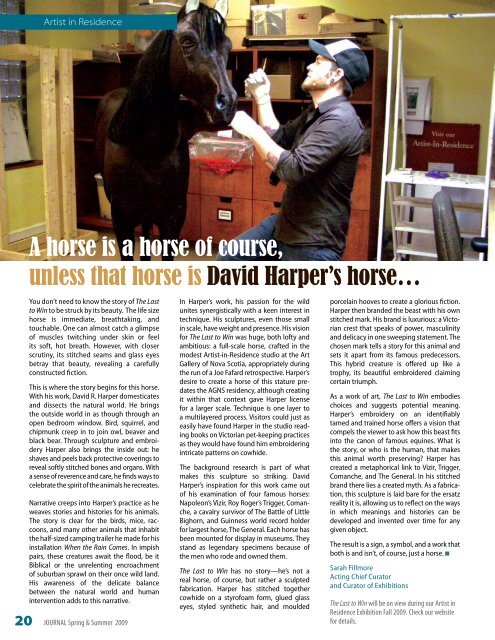
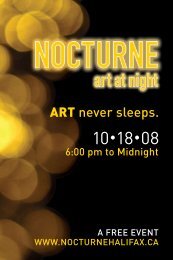
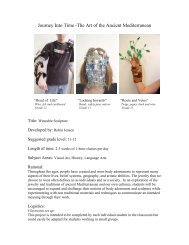
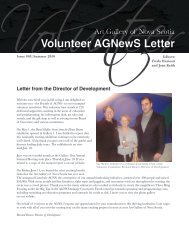
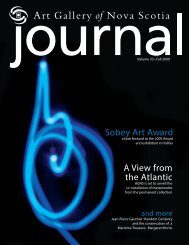

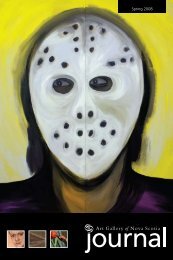

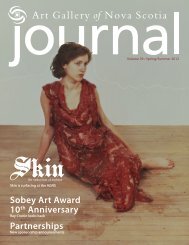
![Elizabeth Bishop - Crazy Quilts and Stories [pdf] - Art Gallery of Nova ...](https://img.yumpu.com/43102277/1/190x245/elizabeth-bishop-crazy-quilts-and-stories-pdf-art-gallery-of-nova-.jpg?quality=85)
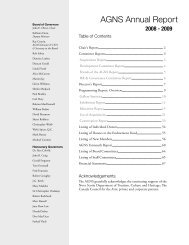
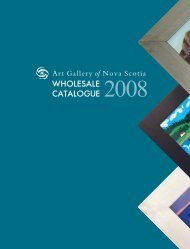

![Senior High lesson plan brochure [pdf] - Art Gallery of Nova Scotia](https://img.yumpu.com/36529943/1/190x146/senior-high-lesson-plan-brochure-pdf-art-gallery-of-nova-scotia.jpg?quality=85)

![Junior High lesson plan brochure [pdf] - Art Gallery of Nova Scotia](https://img.yumpu.com/35457408/1/190x146/junior-high-lesson-plan-brochure-pdf-art-gallery-of-nova-scotia.jpg?quality=85)